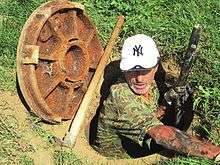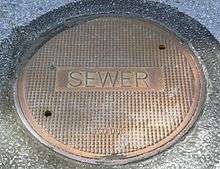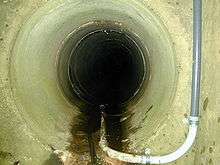Sanitary sewer

A sanitary sewer (also called a foul sewer and a covered sewer) is an underground carriage system specifically for transporting sewage from houses and commercial buildings through pipes to treatment or disposal. Sanitary sewers serving industrial areas also carry industrial wastewater. The system of sewers is called sewerage.
Sanitary sewers are distinguished from open sewers in that the sanitary system is closed off from its surroundings to limit interaction between the waste and the landscape that it travels through. They are also usually distinguished from combined sewers, which handle not only sewage but also surface runoff. Open sewers, consisting of gutters and urban streambeds, were common worldwide before the 20th century. In the majority of developed countries, large efforts were made during the late 19th and early 20th centuries to cover the formerly open sewers, converting them to closed systems with cast iron, steel, or concrete pipes, masonry, and concrete arches. Open sewers are not used in developed countries today, but they remain in use in many developing countries.
Nomenclature




In the developed world, sewers are usually pipelines that begin with connecting pipes from buildings to one or more levels of larger underground trunk mains, which transport the sewage to sewage treatment facilities. Vertical pipes, usually made of precast concrete, called manholes, connect the mains to the surface. Depending upon site application and use, these vertical pipes can be cylindrical, eccentric or concentric. The manholes are used for access to the sewer pipes for inspection and maintenance, and as a means to vent sewer gases. They also facilitate vertical and horizontal angles in otherwise straight pipelines. Sewers are generally gravity powered, though pumps may be used if necessary.
Pipes conveying sewage from an individual building to a common gravity sewer line are called laterals. Branch sewers typically run under streets receiving laterals from buildings along that street and discharge by gravity into trunk sewers at manholes. Larger cities may have sewers called interceptors receiving flow from multiple trunk sewers. A lift station is a gravity sewer sump with a pump to lift accumulated sewage to a higher elevation. The pump may discharge to another gravity sewer at that location or may discharge through a pressurized force main to some distant location.[2]
Maintenance
All sewers deteriorate with age, but infiltration/inflow is a problem unique to sanitary sewers, since both combined sewers and storm drains are sized to carry these contributions. Holding infiltration to acceptable levels requires a higher standard of maintenance than necessary for structural integrity considerations of combined sewers.[3] A comprehensive construction inspection program is required to prevent inappropriate connection of cellar, yard, and roof drains to sanitary sewers.[4] The probability of inappropriate connections is higher where combined sewers and sanitary sewers are found in close proximity, because construction personnel may not recognize the difference. Many older cities still use combined sewers while adjacent suburbs were built with separate sanitary sewers.
For decades, when sanitary sewer pipes cracked or experienced other damage, the only option was an expensive excavation, removal and replacement of the damaged pipe, typically requiring street repavement afterwards. In the mid-1950s a unit was invented where two units at each end with a special cement mixture in between was pulled from one manhole cover to the next, coating the pipe with the cement under high pressure which then dried at a fast rate, sealing all cracks and breaks in the pipe.[5]
Simplified sewers
Simplified sanitary sewers consist of small-diameter pipes (typically 100 mm or about 4 inches), often laid at fairly flat gradients (1 in 200). The investment cost for simplified sanitary sewers can be about half the cost of conventional sewers. However, the requirements for operation and maintenance are usually higher. Simplified sewers are most common in Brazil and are also used in a number of other developing countries.
History
Animal feces were plentiful on city streets while animal-powered transport moved people and goods. Accumulations of animal feces encouraged dumping chamber pots into streets where night soil collection was impractical.[6] The earliest sewers were designed to carry street runoff away from inhabited areas and into surface waterways without treatment. Indoor plumbing was often drained to combined sewers through the 19th century. Sewage treatment facilities built for combined sewers become ineffective during periods of precipitation or snowmelt.[7] Cities were built with sanitary sewers operated separately and independently of storm drains carrying the runoff of rain after wagons and carriages powered by internal combustion engines reduced the advantages of treating street runoff; but many cities built prior to the twentieth century have not replaced combined sewer infrastructure.[8]
See also
- Blackwater (waste)
- Buchan trap
- Combined sewer
- Sanitary sewer overflow (SSO)
- Sewage treatment
- Stormwater
- Vacuum sewer
- Water pollution
References
- ↑ Tilley, E., Ulrich, L., Lüthi, C., Reymond, Ph., Zurbrügg, C. (2014) Compendium of Sanitation Systems and Technologies - (2nd Revised Edition). Swiss Federal Institute of Aquatic Science and Technology (Eawag), Duebendorf, Switzerland. ISBN 978-3-906484-57-0.
- ↑ American Society of Civil Engineers and Water Pollution Control Federation Design and Construction of Sanitary and Storm Sewers (1969) pp.2&288
- ↑ Hammer, Mark J. Water and Waste-Water Technology (1975) John Wiley & Sons ISBN 0-471-34726-4 p.442
- ↑ Steel, E.W. and McGhee, Terence J. Water Supply and Sewerage (1979) McGraw-Hill ISBN 0-07-060929-2 p.22
- ↑ "Sewer Sealing Machine Patches Cracks Underground." Popular Mechanics, April 1956, p. 86.
- ↑ "The History of Toilets". Mary Bellis. Retrieved 2013-12-16.
- ↑ U.S. Environmental Protection Agency (EPA), Washington, D.C. (2004)."Report to Congress: Impacts and Control of CSOs and SSOs." August 2004. Document No. EPA-833-R-04-001.
- ↑ Metcalf & Eddy, Inc. (1972). Wastewater Engineering. (New York: McGraw–Hill.) p.119.
External links
| Wikimedia Commons has media related to Sanitary sewer. |
- Experiences and Challenges in Sewers: Measurements and Hydrodynamics (2008), International Meeting on Measurements and Hydraulics of Sewers IMMHS'08, Hydraulic Model Report No. CH70/08, University of Queensland, Brisbane, Australia, 114 pages (ISBN 9781864999280)
| |||||||||||||||||||||||||||||
| ||||||||||||||||||||||||||||||||||||||||||||||||
